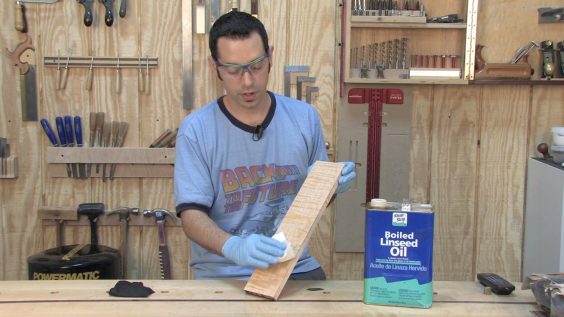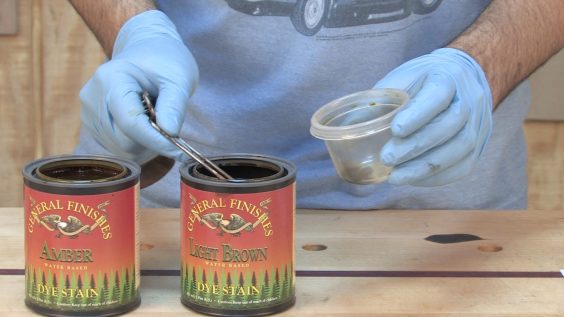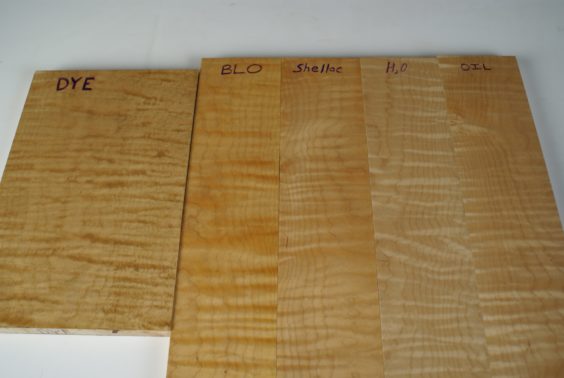47 – Turning Water into Oil
Video - April 26, 2008
What’s Wrong With Water-Based?
I get quite a few questions about water-based finishes and how to make them look more like oil-based finishes. It’s a common problem since water-based finishes are “water-white,” which means they don’t impart any color to the wood and have the potential to leave the surface looking lifeless and boring. This can be beneficial in some situations where that look is desired but many times we want the wood to really pop, showcasing the beautiful grain patterns with a warm glow. Most water-based finishes simply don’t provide that look straight out of the can.
Why Not Just Use Oil-Based?
If you want the look of oil-based finish, the best way to attain it is to use oil-based finish. But some people have a strong preference for water-based topcoats because of their quick dry times and the fact that they are better for us and better for the environment. Furthermore, some people can’t even get oil-based finishes anymore like many of our fellow woodworker in California.
What Can We Do?
There are quite a few tricks we can employ to help water-based finishes look a little more like oil-based finishes and we’ll cover three of those here.
Method #1 – Oil Base-Coat
 Start with a generous coat of boiled linseed oil. Wipe off the excess and keep an eye on the piece for the next few hours to make sure oil doesn’t seep out of the pores. Let the oil cure for at least a week before attempting to topcoat with water-based finish. To speed up the process, you can use dewaxed shellac as a binder between the oil and the water-based finishes, as demonstrated in the video. That should save you a significant amount of time.
Start with a generous coat of boiled linseed oil. Wipe off the excess and keep an eye on the piece for the next few hours to make sure oil doesn’t seep out of the pores. Let the oil cure for at least a week before attempting to topcoat with water-based finish. To speed up the process, you can use dewaxed shellac as a binder between the oil and the water-based finishes, as demonstrated in the video. That should save you a significant amount of time.
Method #2 – Dye Base-Coat
 Start with a dilute dye solution of your preferred color. I used a mixture of two colors to arrive at something that appeared similar to an oil finish: General Finishes Amber and General Finishes Light Brown. With the dye on the surface, it’s not a bad idea to seal in the color with dewaxed shellac before proceeding with the water-based topcoat, since water can reactivate the dye. This doesn’t happen much with General Finishes water-based dyes though because they are pre-mixed with a binder. But it’s something to be aware of with other brands.
Start with a dilute dye solution of your preferred color. I used a mixture of two colors to arrive at something that appeared similar to an oil finish: General Finishes Amber and General Finishes Light Brown. With the dye on the surface, it’s not a bad idea to seal in the color with dewaxed shellac before proceeding with the water-based topcoat, since water can reactivate the dye. This doesn’t happen much with General Finishes water-based dyes though because they are pre-mixed with a binder. But it’s something to be aware of with other brands.
Method #3 – Orange Shellac Base-Coat
 Shellac comes in lots of different colors but I find a 2lb cut of orange shellac can make a nice color transformation that looks similar to oil, at least to my eye. I make my own shellac from flakes, mixing them with denatured alcohol until thoroughly dissolved.
Shellac comes in lots of different colors but I find a 2lb cut of orange shellac can make a nice color transformation that looks similar to oil, at least to my eye. I make my own shellac from flakes, mixing them with denatured alcohol until thoroughly dissolved.
Conclusions
 Well first thing’s first. The water-based and oil-based controls don’t look as different as I anticipated. This could be simply due to the brands/types of finish I used and could also be a very good sign that modern water-based finishes are starting to look better and better on light-colored woods. But nonetheless, there is a difference and over time the oil-based board will continue to get darker.
Well first thing’s first. The water-based and oil-based controls don’t look as different as I anticipated. This could be simply due to the brands/types of finish I used and could also be a very good sign that modern water-based finishes are starting to look better and better on light-colored woods. But nonetheless, there is a difference and over time the oil-based board will continue to get darker.
The boiled linseed oil board actually looks the most amber of all, even more so than the oil-based varnish control. So if you really like that oil look, the BLO will probably get you there. Just keep in mind that using boiled linseed oil brings with it extra steps and additional wait time for the oil to cure, so it might make the process a little more complex than it’s worth.
The dye board has a very nice color but it also exhibits a grain popping effect. This can be good or bad depending on your goals but when using figured wood like I did in this experiment, the dye seeps into the thirsty grain pockets and enhances the wavy effect in the grain.
The orange shellac board, in my opinion, looks the best. It looks closest to the oil-based varnish control and also happens to be the easiest method of the three. And since I often coat my projects with dewaxed shellac before my oil-based finishes just to avoid other finishing problems, it’s not too much of a stretch for me to simply use orange shellac instead.
So for me, orange shellac is probably the winner with the dye board being a close second. But take a look at the picture and decide for yourself!



